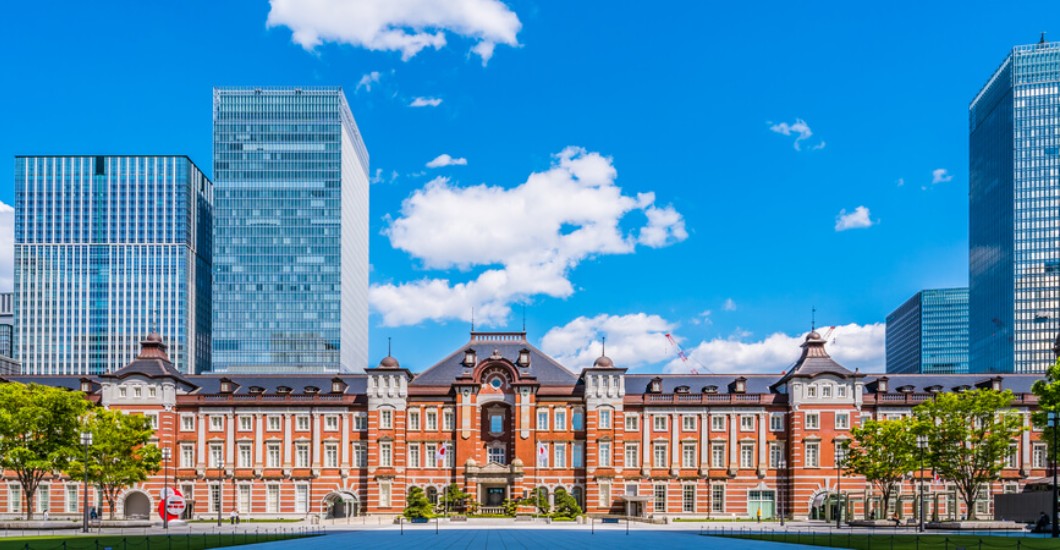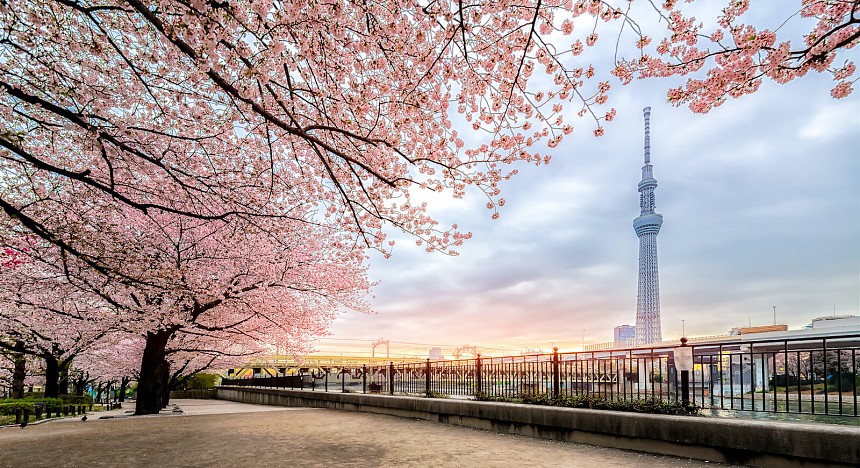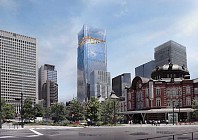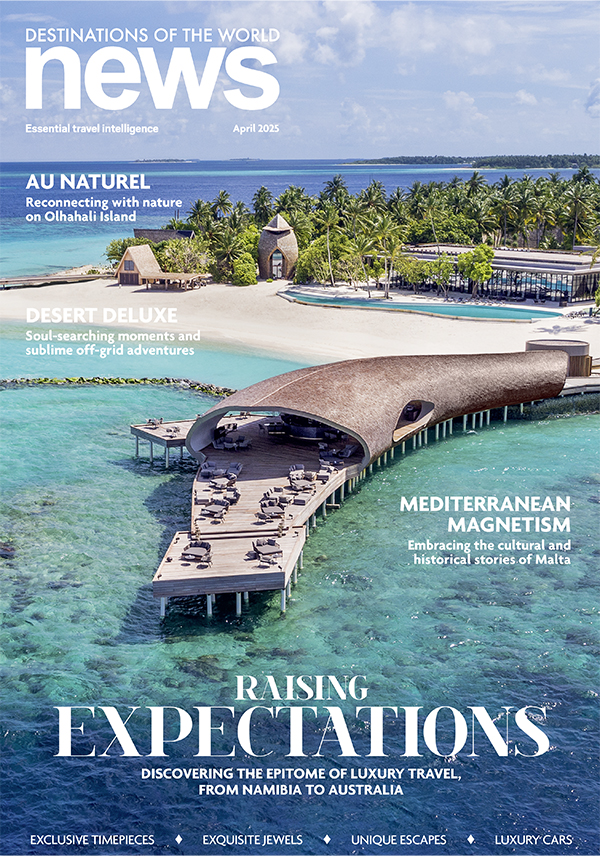Tokyo sits at the intersection of tradition and technology, where ancient pagodas stand next to vivid neon signs. But are its lights still shining as brightly after the pandemic?
12:00 - It’s not often that it’s worth taking a plane flight just for the view from the window but a trip to Tokyo is one of the exceptions. On a clear day you get a view of Mount Fuji that can’t be found from any skyscraper or hotel as the majestic mountain can be seen peeking through the clouds. It takes almost 10 hours to fly from Abu Dhabi to Tokyo with Etihad and if you’re lucky enough to be in business you won’t be bleary-eyed for the big moment. There’s a seat that folds into a flat bed and a massager in case you struggle to nod off. The windows aren’t big enough to get a selfie with Fuji in the background, but you won’t get a more iconic image that says you’ve arrived in Japan.

14:00 - After you make it across the border there is no doubt where you’ve landed, as massive posters of Super Mario and Hello Kitty adorn the walls of the airport. Cute characters are a tradition in Japan and promote everything from airlines and air fresheners to police and security services. Friendly robots even roam around Narita declaring that they are carrying out security checks. In stark contrast, the ticket machines for trains from the airport to Tokyo Station (the city’s central hub) don’t take international credit cards so you’ll need to get cash out. Don’t hang around though as Japanese trains are always (and I mean always) on time.

15:00 - You haven’t been in a crowd until you’ve been to Tokyo Station. Shuffling along in a sea of people so deep that you can’t see to the end of the corridor isn’t for the faint-hearted. Thankfully the signs hang from above so you can still find your way. Head for the one marked Yaesu Central Gate where you can find respite in the Japan Rail Café, a gleaming glass and steel monument to Japan’s futuristic bullet trains, or Shinkansen as the locals call them. Boost your energy levels here with some salmon sashimi – fresh fish which is sliced into thin pieces so it can be dipped into soy sauce.
15:30 - Once you’ve recovered, log on to the café’s free wi-fi to email the concierge of the Four Seasons Hotel Tokyo at Otemachi. The hotel opened in 2020 so is as cutting-edge as you can get whilst also offering the services that Four Seasons has become famous, for such as its complimentary limos. The hotel is only five minutes from the station, but you’ll be thankful for the ride as you breeze past the crowds cramming the streets outside. Tokyo is a city of stark contrasts. Wooden temples with traditional sloping, blue-tiled roofs sit next to huge neon signs on street corners. Soaring skyscrapers overlook ancient imperial gardens and, unlike many of its counterparts, the Four Seasons is as understated as they come. In fact, you’ll struggle to know when you’ve arrived.

16:00 - The lobby of the hotel looks more like a smart office with the most distinctive feature being the red frame around the door which looks all the more striking against the room’s grey and brown colour-scheme. It’s smaller than most hotel suites but this isn’t down to minimalism. Instead, a smartly-suited doorman leads you to a lift and when the doors open you’re rewarded with one of the most stunning views of any hotel in the world. The hotel takes up the top six floors of a 39-storey tower and if you arrive in the afternoon, sunlight floods the lobby from the floor-to-ceiling windows making you feel far from the worries of the world below.

The rooms epitomise the contrasts of Tokyo as they have dividers made from stiffened white sugar paper as you would find in ancient Japanese dojos where warriors trained in martial arts. Adding to this atmosphere, the carpets are silver-coloured to resemble stone floors, the lamp shades look like they are made from origami and there’s a display of driftwood and a bonsai tree beside the bed. This traditionalism belies high-tech touches, such as an iPad next to the bed which can be used to call room service or contact the concierge. Even the toilet is cutting-edge and has a control panel which wouldn’t look out of place in the space shuttle. It has a massager, a perfume dispenser and a heated seat which levitates automatically when you open the bathroom door.

The blinds also magically rise when you come into the room to reveal that jaw-dropping view of Fuji in the background, as it sits majestically opposite the hotel. To the left is the soaring Sky Tree with the skyscrapers of Shinjuku in the distance and the iconic red and white Tokyo Tower broadcasting mast just in front of them. The city looks like a toy town from up here so you can plot your path just by looking out the window.

16:30 - A short stroll away is the Ginza shopping district which is home to chain stores and Japanese gems. Mitsukoshi is Tokyo’s rival to Harrods and even has statues of lounging lions at the entrance which look just like the ones sitting in London’s Trafalgar Square. It’s full of pricey products but worth a visit to see the soaring statue in the central hall which looks like sea urchin but is meant to be an oriental goddess.

For something more affordable stop at Itoya, one of Japan’s most famous stationery companies. A temple to paper, the store’s 12 floors sell everything from notepads and postcards to origami sets. It takes its organic credentials so seriously that it even has a café which serves food grown in its high-tech vegetable factory. Grab a bite to eat here but don’t slug down too much soda.


The best drink in town is found in nearby Marunouchi in the Tokyo flagship of Ippodo, one of Kyoto’s most well-known tea companies. Afternoon tea is almost as big in Japan as it is in Britain and Ippodo is the epicentre of it all. The store is home to a tearoom which doesn’t just sell customers a cuppa, it also teaches you the correct way to make it and helps you find your perfect blend. If you want to know whether your tipple is more Matcha then Moroccan Mint Green, this is the place to be. Make sure you leave with some Japanese green tea. It comes in turquoise tins and couldn’t look much more traditional.

17:30 - Time to return to the hotel to further enjoy its complimentary limo. Get the driver’s number in case you need it later and tell him to take you to the fashion district of Harajuku where cosplayers congregate on the colourful pedestrianised street Takeshita Dori. Its shops sell an eclectic mix of kitsch items and vintage clothing, but in typical Tokyo style one of the city’s most serene shrines is just a stone’s throw away from this hustle and bustle. Just behind Harajuku station a path lined with dense forest leads to Meiji Jingu, an elegant Shinto shrine, complete with the tall wooden torii gates. Japan is famous for these traditional red and black entrance ways, but Meiji Jingu isn’t a tourist trap. It’s off the beaten path making it a perfect place to steel yourself for what’s to come.
19:00 - Head back to Harajuku for dinner at Maisen where you can nosh on delectable chicken katsu sandwiches served up in the atmospheric setting of a former public bathhouse. After that, jump on the Metro and go two stops to Shinjuku for a night-time experience like no other. Here you’ll find the Cross Shinjuku Vision, a giant digital billboard showing footage which looks 3D even though it’s flat. If you stand in the right place, it appears as if a huge cat is reaching out of the screen, but getting the shot is no mean feat as swarms of people stream across the road. Right next to the neon signs and skyscrapers, colourful lanterns criss-cross the alleys above outdoor barbecues in another reminder of Tokyo’s two sides. It’s even apparent in individual shops.

20:00 - From the ground floor, Odakyu in Shinjuku appears to be a high-end department store with jewellery boutiques that wouldn’t look out of place in Harvey Nichols. However, with every floor it gradually becomes more and more frenetic, with the top floor resembling an indoor market crammed with games consoles and toys. As you ascend the escalators watch out for techno-geeks, known in Japan as Otaku, barging past you in a bid to be the first in line for late night game releases. When you can’t bear it any longer, speed dial the hotel’s driver so that he can parachute you out of there and back to the Four Seasons for some sweet dreams.
08:00 - It’s hard to beat waking up in the land of the rising sun and watching it appear from behind Mount Fuji in the morning. Make the most of this golden hour by grabbing a jogging map from the room and hitting the concrete to take in the local area. Otemachi is Tokyo’s business district, but during the Edo era it was where wealthy samurais and merchants built their lavish mansions.

The clearest evidence of this is found in the sprawling Imperial Palace Gardens opposite the hotel. Japan’s emperor still lives here in a traditional pagoda and although entry into the grounds is restricted, you can get a good view from the rooms in the Four Seasons. If you look hard enough you can even see the remnants of Edo Castle where ancient Tokugawa Shoguns lived and ruled. The jogging trail takes you as close as you can get without being a royal as it crosses the moat and passes the historic Nippon Budokkan judo centre built for the 1964 summer Olympics. In spring, cherry blossom lines the paths making it even more of a spiritual setting.
10:00 - No trip to Tokyo would be complete without seeing something genuinely futuristic and that requires travelling a little further afield. Ask the concierge to book tickets to teamLab Planets at Yurikamome and hop in the limo to get there. A cross between an art exhibition and an avant-garde audio-visual installation, Planets’ rooms immerse visitors in surreal landscapes which are connected to each other by a rabbit warren of dark corridors.

Despite its name, marine is the dominant theme of Planets as you walk around barefoot and splash through water up to your ankles in some of the rooms. In one, a wading pool appears to be filled with Koi carp which are projected onto the water. Thanks to some high-tech wizardry, the fish swim away if you chase them and if you manage to catch up with them, they burst into flowers. The highlight is a room which has a mirrored floor and ceiling with orchids hanging from it. They reflect in the surfaces, so it looks like you’re in the middle of an endless jungle. Guests are advised to wear shorts which can be easily rolled up over their knees and skirts are to be avoided due to the mirrors on the floors.

12:00 - If you think you won’t be able to top your snaps from Planets, think again. Just across the bay is Tokyo Disney Resort which might not sound like a unique destination but is unlike any other theme park. It’s the only Disney resort which isn’t owned or run by Disney, and it shows. Unlike its American counterparts, the park mainly attracts couples who often turn up dressed like they are going to the theatre. There is good reason for this as one of the shows here is a jazz spectacular in full-size Broadway theatre featuring a proscenium arch, a brass band, tap dancing and piano solos. There are two parks – a carbon copy of the fairy tale-themed Magic Kingdom in Orlando and DisneySea, which is the one to tell the driver to make a bee-line for.

13:00 - Make sure you download the park app when you arrive at DisneySea as the pandemic put an end to paper maps. The Park isn’t themed to cartoons but is instead based on different ports around the world from Cape Cod to Venice. The latter looks flawless with its crumbling bridges and weathered brickwork. Buildings have traditional terracotta roof tiles and street names on the corners of the walls. Trellises hang from ornate iron railings on balconies whilst windows have colourful canopies above them. They don’t just have wooden shutters; the paint looks like it is cracking off them and posters appear to be peeling off the walls. Be prepared to smile when you Tweet photos from here and friends to reply that they hope you’re enjoying Italy.
Instead of having a cartoony castle in the middle of DisneySea, there’s a gigantic volcano which spews out huge fireballs, steam and plumes of smoke. No stone has been left unturned and there are even figs (you can smell them) growing on the side of it. The volcano houses attractions themed to the stories of Jules Verne which aren’t what you expect to find in a Disney Park. Most of the rides are unique to the park and even the kiddie attractions are cerebral. They sit inside a Renaissance era Italian fortress and include a planetarium and a pendulum showing how the rotation of the earth was demonstrated in medieval times. It’s far from Mickey Mouse.

18:00 - Take the Japan Rail Keiyo line from Tokyo Disney’s stop, JR Maihama, to Tokyo Station then stroll back to the Four Seasons to continue the Italian theme. The hotel’s restaurant Pigneto serves pizzas made with handmade Italian dough and burrata from Hokkaido. The bases are crisp, the salads are sumptuous, and the setting is like an upscale diner.
20:00 - Instead of retiring to your room, head for Virtu, the hotel’s bar which is hidden behind what appears to be an ancient Japanese library. The bar has an Art Deco air with chequered marble floor tiles, mahogany shelves, and golden railings. Silvery tree branches hang on the wall illuminated by an intricate chandelier formed from wooden poles with integrated bulbs arranged into a geometric shape. Attractive as it may be, it’s hard to take your eyes off the view. The bar is on the 39th floor affording sparkling night-time views of the city. From up there you can see all the places you have been and all the sights you have missed because 48 hours in Tokyo barely scratches the surface.

Words by Christian Sylt and Caroline Reid










